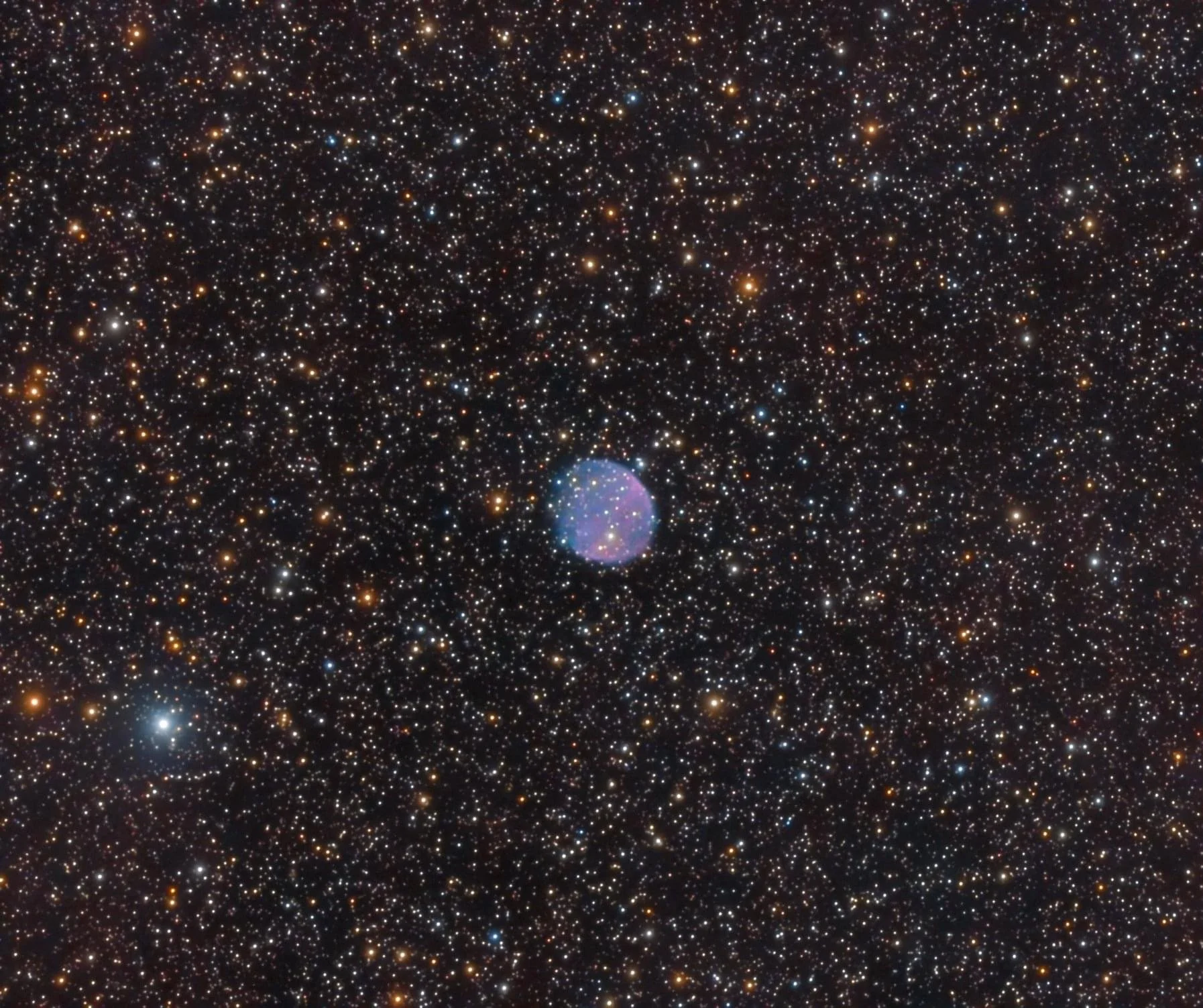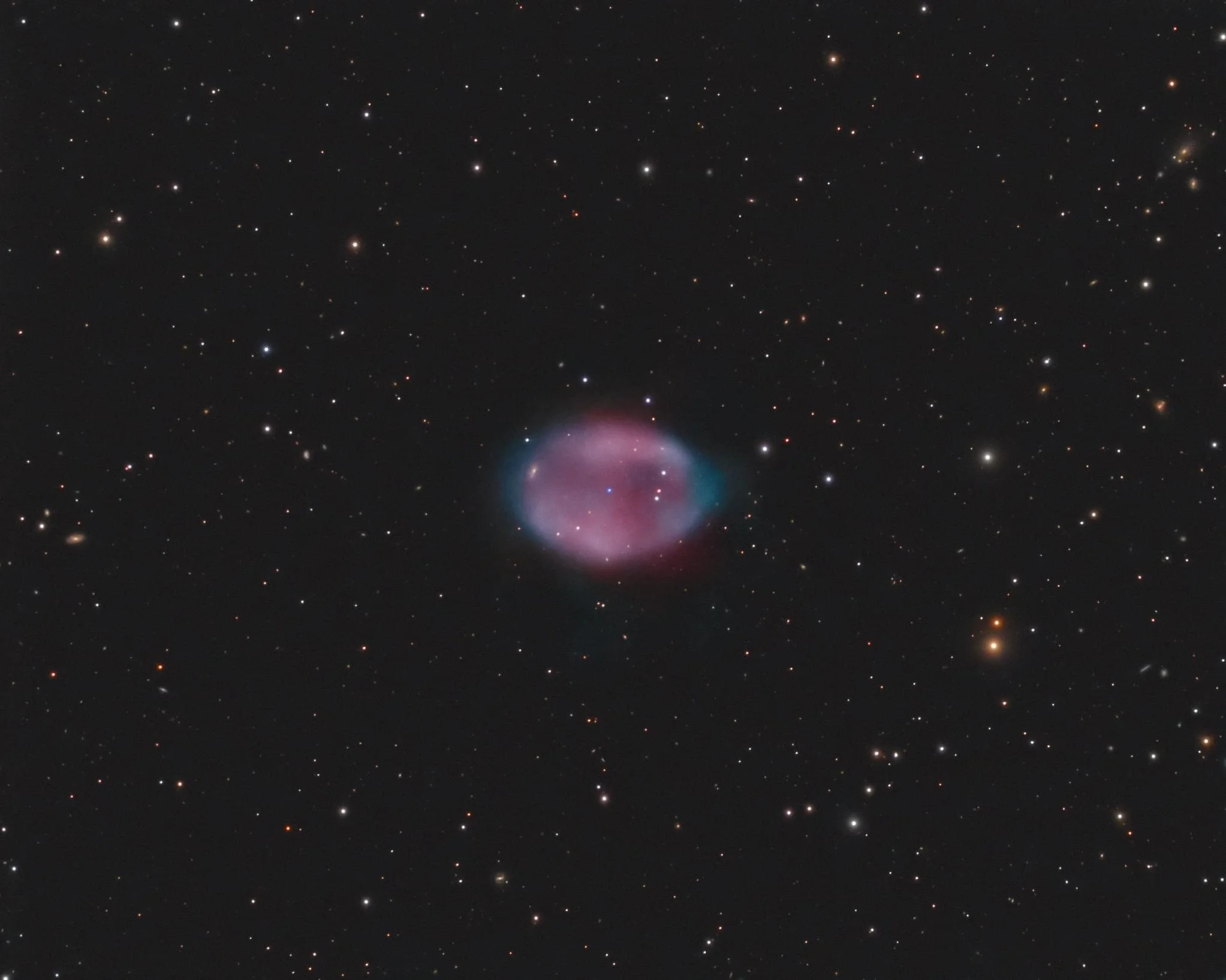
AAPOD2 Image Archives
Weinberger 3-1
Weinberger 3-1 (We3-1, PK044+10.1, PN G044.3+10.4) is a planetary nebula in the constellation Hercules.
A nice oval planetary nebula that measures approximately 3 arcminutes. It was discovered in 1978 by Ronald Weinberger.
This image taken over several nights in August 2021.
R-channel - 48 x 150 sec. bin 1x1;
G-channel - 48 x 150 sec. bin 1x1;
B-channel - 48 x 150 sec. bin 1x1;
Ha- 40 x 900 sec. bin 2x2;
OIII- 40 x 900 sec. bin 2x2.
Total integration time about 26 hours.
My setup: Telescope 8" Celestron Schmidt-Cassegrain (SCT) CPC800 GPS (XLT) on the equatorial wedge, focal reducer Starizona Night Owl 0.4х, Feq=864mm, camera Starlight Xpress Trius SX694, SX mini filter wheel, filters Astrodon LRGB E-series gen.2, Astrodon Ha 5nm, Astrodon OIII 3nm.
Capture and processing software: MaxIm DL6, PHD2, PixInsight, StarTools, Photoshop CC, Zoner photo studio 14.
North at the top.
Copyright: Boris
PN G136.7+61.9
PN G136.7+61.9 is a planetary nebula in Ursa Major.
PN G136.7+61.9 is extremely faint planetary nebula with size of about 7 arcminute that was discovered in 2013 by analysing data from the SDSS spectroscopic survey. The Sloan Digital Sky Survey or SDSS is a major multi-spectral imaging and spectroscopic redshift survey using a dedicated 2.5m wide-angle optical telescope at Apache Point Observatory in New Mexico, United States. The project was named after the Alfred P. Sloan Foundation, which contributed significant funding.
This is the first colour image ever taken of PN G136.7+61.9 planetary nebula. In appearance, as well as low surface brightness, this planetary nebula could be called "Night Owl Nebula".
This image taken over several nights in May 2021.
L-channel - 52 x 150 sec. bin 1x1;
R-channel - 24 x 150 sec. bin 1x1;
G-channel - 24 x 150 sec. bin 1x1;
B-channel - 24 x 150 sec. bin 1x1;
Ha- 59 x 900 sec. bin 2x2;
OIII- 50 x 900 sec. bin 2x2.
Total integration time about 32:25 hours.
My setup: Telescope 8" Celestron Schmidt-Cassegrain (SCT) CPC800 GPS (XLT) on the equatorial wedge, focal reducer Starizona Night Owl 0.4х, Feq=864mm, camera Starlight Xpress Trius SX694, SX mini filter wheel, filters Astrodon LRGB E-series gen.2, Astrodon Ha 5nm, Astrodon OIII 3nm.
Capture and processing software: MaxIm DL6, PHD2, PixInsight, StarTools, Photoshop CC, Zoner photo studio 14.
North at the top.
Copyright: Boris Vladimirovich
NGC 1333 Embryo Nebula
NGC 1333 Embryo Nebula in the constellation Perseus.
The NGC 1333 reflection nebula and its associated dark cloud L1450 (also known as Barnard 205) are located at the northern end of a degree-long, north-south ridge of CO emission in the Perseus region at the west side of a large cavity in the Perseus molecular cloud.
L-channel - 36 x 600 sec. bin 1x1;
R-channel - 25 x 600 sec. bin 1x1;
G-channel - 25 x 600 sec. bin 1x1;
B-channel - 25 x 600 sec. bin 1x1.
Total integration time - 18:30 hours.
My setup: Telescope 8" Celestron Schmidt-Cassegrain (SCT) CPC800 GPS (XLT) on the equatorial wedge, focal reducer Starizona 0.75x, Feq.= 1626mm, camera Starlight Xpress Trius SX694, SX mini filter wheel, filters Astrodon LRGB E-series gen.2 .
Capture and processing software: MaxIm DL6, PHD2, PixInsight, StarTools, Photoshop CC, Zoner photo studio 14.
North at the top.
Copyright: Boris Vladimirovich
The Blinking Nebula, NGC 6826 (Caldwell 15, PK 83+12.1)
The Blinking Nebula, NGC 6826 (Caldwell 15, PK 83+12.1) is a planetary nebula located in the constellation Cygnus.
The nebula is located at a distance of about 2000 light years, the central part has a visible size of 27″x 24″ and a visual magnitude of 8.8m.
Date taken in August 2019.
R-channel - 158 x 5 sec. bin 1x1;
G-channel - 158 x 5 sec. bin 1x1;
B-channel - 158 x 5 sec. bin 1x1;
Ha- 38 x 600 sec. bin 1x1;
OIII- 36 x 600 sec. bin 1x1.
Total integration time about 13 hours.
Setup: Telescope 8" Celestron Schmidt-Cassegrain (SCT) CPC800 GPS (XLT) on the equatorial wedge, focal reducer Starizona 0.75x, Feq.= 1626mm, camera Starlight Xpress Trius SX694, SX mini filter wheel, filters Astrodon LRGB E-series gen.2, Astrodon Ha 5nm, Astrodon OIII 3nm.
Capture and processing software: MaxIm DL6, PHD2, PixInsight, StarTools, Photoshop CC, Zoner photo studio 14.
North at the top.
Copyright : Boris Vladimirovich




